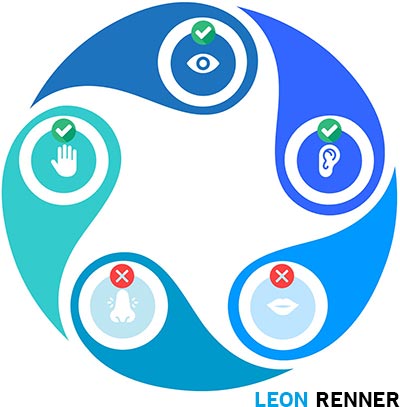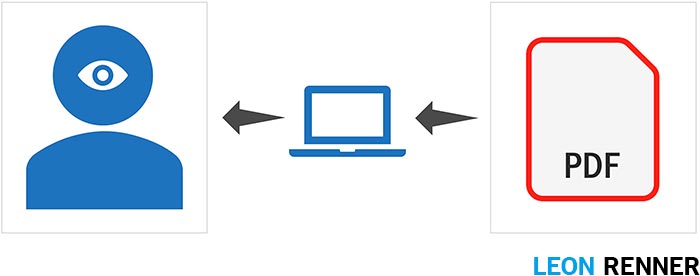An accessible PDF is a digital document in PDF format whose full content is (also) accessible to people with disabilities when the appropriate hardware and software is used. Or from a different point of view: if a person with disabilities (e.g. blindness) cannot perceive the content of a document despite the use of suitable software (e.g. screen reader), then the document is inaccessible (e.g. because it isn’t machine readable).
But what exactly does that mean?
Information reception in humans
When all 5 sensory organs are functioning, we can take in information through smell, taste, touch, hearing and sight. For the transmission of a large amount of information, the sense of smell and the sense of taste are of course irrelevant. So we almost exclusively use sight or hearing or both. We additionally need our sense of touch to gain access to information – for example, by leafing through a book.

Information reception from PDF files
PDF files mimic a digital version of a physical written document. They are therefore primarily designed to display information visually. And with that, PDF software is also specialized in the visual representation of information. Over the years, more and more functions have been added, so that PDF documents can now also contain audio and video, but this is extremely rare.

Emergence of inaccessibility
And with this background information, it can also be clarified relatively quickly how inaccessibility can arise in the transmission of information between the PDF and a human. This happens exactly when the relevant sensory organ is restricted. In the case of a PDF document, the inaccessibility mainly arises when the sense of sight is impaired. Of course, a barrier can also arise if the document contains audio tracks in rare cases and the sense of hearing is limited. Or if the document can only be operated using complex input methods and the sense of touch is limited. However, the last two barriers mentioned almost never occur.
Requirements for an accessible PDF
Now, the goal of an accessible PDF is to remove the barriers so that the entire content can also be perceived with impairments. And this results in the requirement that the content is not only made available visually (as typically already the case), but also audibly – and that it is additionally easy to use.
Technical realization
Just as there is suitable software for the visual display of a PDF, there is also suitable software for the auditive transmission of information. These are so-called screen readers. We therefore don’t need to record the visual content as an additional audio track, but simply have to ensure that the document is machine-readable. This results in the following exemplary requirements:
- Each element of the document must be tagged, i.e. provided with a label, so that the software knows whether it is a normal paragraph, a heading, a list, a link or something else. This is a basic requirement for making the PDF machine-readable. In addition, it allows the user to jump back and forth within a respective group of elements (e.g. headings). This makes it easy for the user to get a quick overview of the document.
- There must be a reading order so that it is clear which content should be read aloud first.
- The document language must be set so that the software pronounces the words correctly.
- For content-relevant illustrations (images, graphs, icons, shapes, etc.), there must be an alternative text that contains all the relevant information of the illustration.
Of course, there are many other technical requirements which are specified in various standards and laws regarding digital accessibility. Find out now about these (standardized and legally defined) technical requirements for accessible PDF documents.
